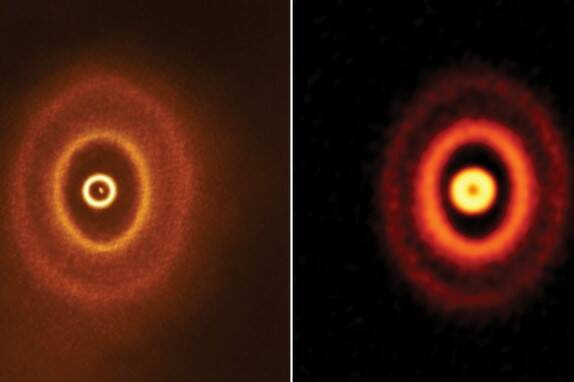UNLV grad’s team may have found first planet orbiting 3 stars
“Star Wars” showed us a planet with two suns in the sky. Now a UNLV researcher and an international team are doing one better: They may have identified the first planet orbiting around three stars.
In a star system 1,300 light years away in the constellation of Orion, Jeremy Smallwood and other researchers believe they’ve detected a planet — not because of what they can see with a high-powered telescope, but what they can’t. They theorize that a gap of nothingness outside the inner ring of gas and dust around the three stars suggests that one or more planets has formed there.
Smallwood, who graduated from UNLV in May with a doctorate in astronomy, used our solar system to explain the team’s theory.
“Once upon a time, before the planets were created, we had this large disc of gas and dust around the sun, and all our eight planets formed within that disc,” he said.
When a planet orbits long enough, it carves a gap in the disc, collecting all the material in its path, he said.
In the star system GW Ori, “We can’t see these planets, right, because they might be too small or too far away,” said Smallwood, 29. “But we can see the gaps,” which he described as “indirect evidence that there’s a planet forming.”
Scientists previously have identified planets orbiting in a triple star system, but they were orbiting around one star or two, not three.
“We know about 20 or so planets that are actually orbiting both stars at once,” Smallwood said. “It kind of resembles Tatooine from ‘Star Wars,’ with those two suns in the sky.”
Of the planets in our solar system, the one Smallwood and his colleagues believe they have detected would most resemble Jupiter, a gas planet, the type that typically forms first in a star system.
“Gas planets form first, when there’s still a disc, and since we still see a disc and we see a gap, we assume it’s a Jupiter- like planet,” he said. “So it’s a big gas giant that’s opening this gap.”
Smallwood was the lead author of an article on the research, published in September by Oxford University Press on behalf of the Royal Astronomical Society.
The team of researchers, some from the United Kingdom and Canada, constructed a comprehensive model using observations from the powerful Atacama Large Millimeter/submillimeter Array (ALMA) telescope in Chile.
The team investigated different reasons for the gap, including the possibility that it was created by gravitational torque from the three stars, but found the planet explanation more likely.
“There’s really no limit to where planets can form, if this is the case,” he said. “I mean, we’ve already seen planets orbiting around two stars, so why can’t they move around three?”
From on the planet, because two of the stars are close together, “I would assume, assuming my imagination, that you would see two points of light.”
Just as “Star Wars” imagined for us.
Contact Mary Hynes at mhynes@reviewjournal.com or 702-383-0336. Follow @MaryHynes1 on Twitter.

















